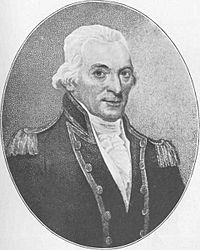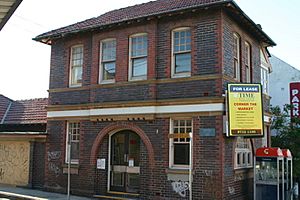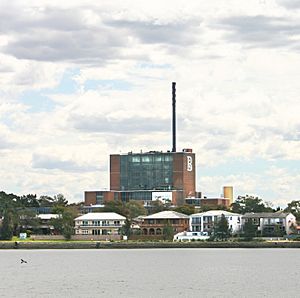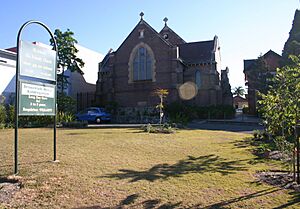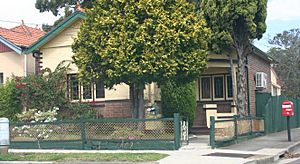Five Dock facts for kids
Quick facts for kids Five DockSydney, New South Wales |
|||||||||||||||
|---|---|---|---|---|---|---|---|---|---|---|---|---|---|---|---|
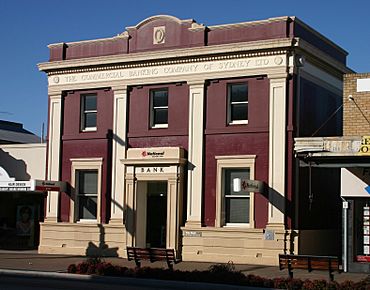
Old bank building on Great North Road, Five Dock
|
|||||||||||||||
| Established | 1794 | ||||||||||||||
| Postcode(s) | 2046 | ||||||||||||||
| Elevation | 22 m (72 ft) | ||||||||||||||
| Area | 2.45 km2 (0.9 sq mi) | ||||||||||||||
| Location | 10 km (6 mi) west of Sydney CBD | ||||||||||||||
| LGA(s) | City of Canada Bay | ||||||||||||||
| State electorate(s) | Drummoyne | ||||||||||||||
| Federal Division(s) | Reid | ||||||||||||||
|
|||||||||||||||
Five Dock is a lively suburb located in the Inner West of Sydney, New South Wales, Australia. It's about 10 kilometers west of Sydney's main city center. This area is part of the City of Canada Bay, which is a local government area.
Contents
Exploring Five Dock's Location
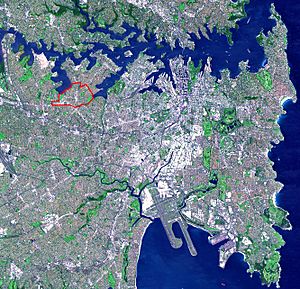
Five Dock is found at the southern end of the Drummoyne peninsula. It sits between two main roads, Parramatta Road and the City West Link, to the south. To the north, you'll find Hen & Chicken Bay, which is part of the Parramatta River. Nearby suburbs like Wareemba and Russell Lea are also to the north. The total area of Five Dock is about 2.45 square kilometers.
To the east, you'll find Rodd Point. Haberfield is to the south-east, and a small part of Iron Cove forms the eastern edge. South of Five Dock, across Parramatta Road, are Ashfield and Croydon. On the western side, Five Dock borders Canada Bay and Concord.
If you measure in a straight line from the General Post Office in Martin Place, Five Dock's shopping center is about 7.5 kilometers from the heart of Sydney. By road, this distance is usually between 9 and 10 kilometers, depending on the route you take.
A Glimpse into Five Dock's Past
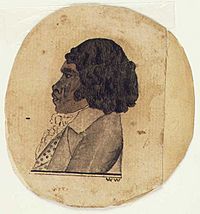
How Five Dock Got Its Name
The name Five Dock first appeared in writing in The Sydney Gazette on February 3, 1805. It referred to Five Dock Bay. Everyone agrees the name comes from the unique shape of the bay along the Parramatta River.
A publication from the Maritime Services Board in 1965 explained that "At the NE point of the bay there were five water worn indentations that were likened to docks, hence the name Five Dock." These "docks" were natural formations in the bay. While some sources say only two of these natural docks remain, others suggest more are still there.
Street Names: A Local Story
Many streets in Five Dock are named after important local figures. These include mayors, aldermen, and others involved in local government. For example, Charles Street, Corden Avenue, and William Street are named this way.
Other streets honor early landowners, developers, or well-known local business people. Examples include Ramsay Road, Taylor Street, and Friend Avenue. Rickard Street and Noble Street were named after Sir Arthur Rickard and his family. Rodd Road and Trevanion Street are named after Brent Clements Rodd and his family. Some streets, like Mackaness Close, are named after local residents.
In August 1908, the Great White Fleet visited Sydney. This was a group of US Navy battleships. Several local street names remember these ships. Connecticut Avenue is named after the USS Connecticut, and Illinois Road after the USS Illinois. Minnesota Avenue and New Jersey Road also take their names from ships in this fleet.
A few streets are named after famous people. Queens Road is named after Queen Victoria. Garfield Avenue honors American President James A. Garfield. Kingsford Avenue is named after the famous aviator Charles Kingsford Smith. Henry Lawson Avenue remembers the poet Henry Lawson, who lived nearby for a short time. Coronation Avenue celebrates the coronation of King George VI and Queen Elizabeth.
Places of Worship
St Alban's Anglican Church is a beautiful Gothic church built in 1924. It's made of brick and stone, using local stone for its strong foundations. The church is very well preserved and is considered a heritage item. Inside, you can admire its detailed carpentry, the pipe organ (built in 1891), and its lovely stained glass windows. The church and its rectory (the priest's house) are on the same large property. In 2008, St Alban's joined with other churches to form the Christ Church Inner West Anglican Community.
Schools in Five Dock
Five Dock is home to several schools, including All Hallows' Parish School, Domremy College, Five Dock Public School, Lucas Gardens School, and Rosebank College.
Five Dock Public School's foundation stone was laid in 1858, and the school officially opened in 1861.
Domremy College Five Dock
Domremy College is a Catholic secondary school for girls. It's named after Joan of Arc's birthplace, Domremy. The school is located on First Avenue, right across from Five Dock Park. It started in 1911 with just 12 students. Over the years, it changed its age range, and since 1985, it has taught girls from Year 7 to Year 12. The Domremy Convent buildings are listed on the NSW Heritage Office State Heritage Register, showing their historical importance.
Homes in Five Dock
Most homes in Five Dock are detached houses, meaning they stand alone. Like many suburbs in Sydney's inner-west, Five Dock has some lovely examples of older Australian home styles. These include Federation architecture and California Bungalow style houses. While many have been updated, some still keep their original charm.
These detached houses often have good-sized gardens. In 2011, a census showed that out of 3,760 homes, 1,676 were separate houses. There were also 1,228 flats or apartments. Even though houses are common, many apartments have been built since World War II. Recently, several big apartment buildings have been finished. For example, the 'Pendium' development on Garfield Street has 102 apartments, a renovated supermarket, and the local library. Another project turned the old EnergyAustralia site into 93 units.
As of 2005, 51 places in Five Dock are listed as heritage items by the NSW Heritage Office. This means they are important historical sites. The skateboard track in Five Dock Park is also being considered for heritage listing.
Shopping and Business Area
Five Dock's main shopping and business area is a long stretch of shops, banks, restaurants, and other services. It runs for about 500 meters along Great North Road, between Lyons Road and Queens Road. You'll find many small local businesses here. There are also several shops selling Italian foods, which shows the large number of residents with Italian backgrounds. The Five Dock telephone exchange is located at 190-192 Great North Road. Coles is now the main supermarket in Five Dock.
Parks and Green Spaces
Five Dock has two public areas along the Parramatta River. One part is a section of the Bay Run, a popular 7-kilometer path for walking and cycling that goes around Iron Cove. The other area is on Hen & Chicken Bay and Kings Bay, with a path leading towards Abbotsford.
There are also several public parks in Five Dock. The three largest are Timbrell Park, Five Dock Park, and Halliday Park. A big part of Barnwell Park Golf Course, owned by Canada Bay Council, is in Five Dock. This golf course was built in stages, with the first nine holes finished in 1964 and the second nine in 1974. Much of the course is on reclaimed land.
Timbrell Park
Timbrell Park has several sports fields for different activities and a building with facilities. It's the home ground for the Five Dock Falcons baseball team. Timbrell Park also has Livvi's Place, a special playground for children of all abilities. This playground was created to help kids with special needs play alongside others. In 2010, Livvi's Place in Five Dock was named the best play space in Australia. Livvi's Cafe, located outside the playground, opened in 2014.
Five Dock Park and Oval
Five Dock Park was the first park in the area, with 28 acres of land bought in 1883. It is listed on the NSW Heritage Office State Heritage Register and features The Five Dock War Memorial. The memorial's foundation stone was laid in 1923 and it was renovated in 1987. The park also has many fun things to do, including a large skateboarding area, a bowling club, tennis courts, and an oval used for junior rugby league and cricket. There are also childcare facilities and an off-leash area for dogs.
The park's skateboarding and bmx area was built in 1979 and was very popular in the 1980s. However, it slowly fell apart. In 2002, it was even called one of the worst skate parks in NSW. Calls for an upgrade led to a new skatepark opening in 2007, built next to the old one.
Getting Around Five Dock
Major roads that go through or near Five Dock include Great North Road, Parramatta Road, Lyons Road, Queens Road, and Ramsay Road.
It takes about 40 minutes to get to Sydney's city center from Five Dock using public transport, like bus routes 437, 438X, or 502.
Five Dock is connected to the city and nearby suburbs by Transit Systems bus routes. As of 2020, some of the bus routes include:
- 406 to Hurlstone Park
- 415 to Chiswick and Campsie
- 437 to City QVB
- 438X and 438N to City Martin Place
- 490 to Drummoyne and Hurstville
- 491 to Hurstville
- 492 to Drummoyne and Rockdale
- 502 to Cabarita Wharf, Drummoyne and City Town Hall
- 530 to Burwood and Chatswood
Future Metro Station
Five Dock will have a new rapid transit station as part of the Sydney Metro West project. This project will connect Westmead to Sydney's city center, making travel even easier.
Who Lives in Five Dock?
Five Dock is a well-established suburb with a population of 9,823 people, according to the 2021 census. The most common backgrounds reported were Italian (23.5%), Australian (20.9%), and English (20.2%). About 63.1% of people were born in Australia. The next most common countries of birth were Italy (7.1%) and China (3.7%).
Most people (64.1%) speak English at home. Other languages spoken include Italian (10.5%), Mandarin (4.0%), and Cantonese (2.6%). For religion, 41.0% of people identified as Catholic, and 29.7% reported having no religion.
Like nearby suburbs, Five Dock has a large community of people from Italian backgrounds. This Italian influence can be seen in the local restaurants, cafes, and delis. Five Dock Public School has taught Italian since 1981, and there are private schools offering Italian classes. Five Dock also hosts an annual street festival called Ferragosto, which is based on a traditional Italian festival.
Famous People from Five Dock
Many interesting people have lived in Five Dock, including:
- Joe Avati, a comedian.
- Jeff Fenech, a famous boxer.
- Lachlan Ilias, a rugby league player.
- Samuel Lyons, an early landowner who bought Five Dock Farm in 1838.
- Peter Dodds McCormick, who composed Australia's National anthem, Advance Australia Fair. He became headmaster of Five Dock Public School in 1865.
- Rex Mossop, a rugby player and sportscaster.
- Duke Tritton, a poet and singer.
Images for kids
-
War Memorial in Five Dock Park.
-
Iron Cove Creek at Timbrell Park.



